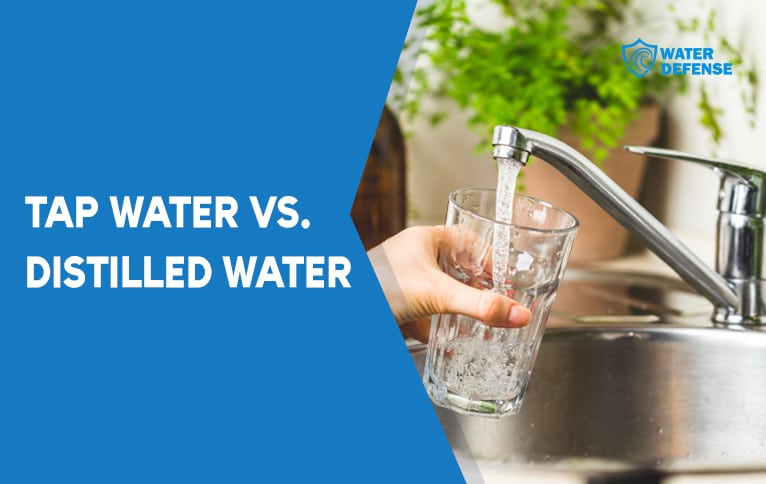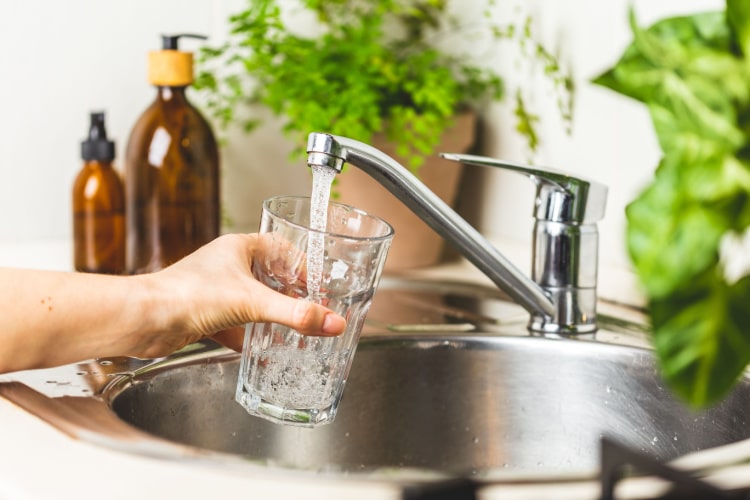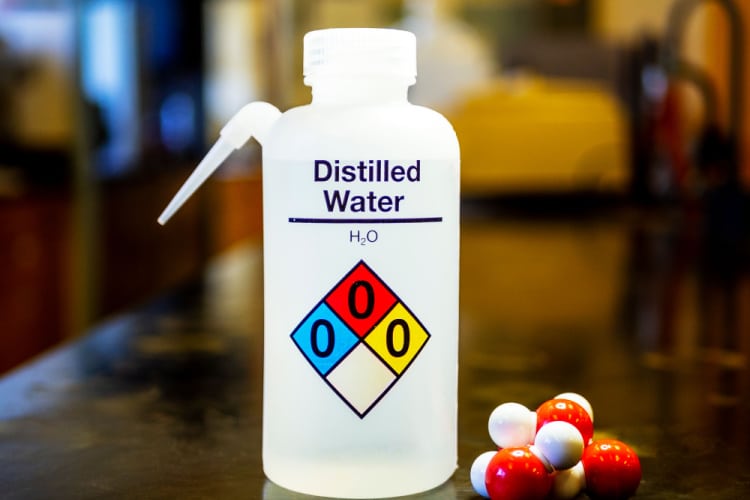From the start of the twentieth century up to the 1970s, Americans mainly preferred tap water to bottled water. During that period, because of the newly developed disinfection methods such as chlorination, American tap water was considered safe and, maybe more importantly, cheap.
Although tap water is still cheaper than bottled water, today, we see more and more cases where citizens question the safety of their tap water and opt for bottled water instead.

Difference Between Tap Water and Distilled Water
The main difference between tap water and distilled water is the presence of contaminants. Tap water may have contaminants, while distilled water has no contaminants or impurities.
Tap water is provided to citizens’ homes through pipelines by municipal authorities or contracted suppliers. It is regulated by the Environmental Protection Agency (EPA) under the Safe Drinking Water Act (SDWA).
The quality of tap water varies because its makeup changes from place to place, and there’s no fixed method of treating it. So, there’s no way of telling what’s inside unless you conduct a water test.
Municipal authorities or suppliers sometimes prefer distilling their raw water (among other treatment methods) before distributing it, as distillation is one of the most effective water treatment methods.
But, this is optional. Almost all municipal authorities in the United States disinfect their pipes and water with chlorine and chloramines and pump fluoride into the water (albeit at safe levels) to promote teeth health. So, tap water is likely to contain disinfectants, disinfection byproducts, and fluoride.
However, using these chemical disinfectants doesn’t guarantee the safety of the water running from your faucets because municipally-supplied water travels through long pipelines, picking up potential impurities along the way.
EPA mandates water suppliers to send annual consumer confidence reports detailing what’s in their water’s makeup. However, these reports inform citizens about the water’s makeup before it leaves the treatment facility of the supplier.
Since pipes are prone to damage and may feature lead or copper components, tap water may contain contaminants — something we see in many American cities.
Furthermore, in addition to contaminants, tap water typically has calcium and magnesium hard water minerals that can harm your appliances and make cleaning chores difficult as they leave a residue.
Bottled distilled water, on the other hand, is sold in supermarkets, through vendors, and online. The United States Food and Drug Administration (FDA) is responsible for its regulation.
Bottled distilled water isn’t a box of surprises since distillation reduces water only to its hydrogen and oxygen molecules, leaving zero impurities. If the water quality doesn’t meet FDA standards, sellers cannot sell it.
The fact that distilled water has to comply with these regulations doesn’t necessarily mean it’s the best choice for drinking. Distillation removes essential minerals alongside impurities, which gives the water a bland taste and decreases its nutritional value.
But it’s much safer than tap water and has no disinfectants, disinfection byproducts, or fluoride. Additionally, the fact it’s free of minerals makes distilled water the ideal choice for cleaning.
Parents who want complete control over their baby’s diet can also use distilled water in baby formulas and infant cereals. Finally, people can also utilize it in appliances such as dehumidifiers, sleep aid machines, and irons.
Tap Water and Distilled Water Comparison Chart
The table below summarizes the differences between tap and distilled water on main water characteristics such as its collection, content, and treatment.
| Key water attributes | Tap water | Distilled water |
|---|---|---|
| Collection | Groundwater or surface water | Water from any source (tap water, well water, spring water, surface water) can be distilled |
| Treatment method | Various treatment methods (including reverse osmosis, microfiltration, distillation, chlorination, ozonation, and so on) | Vapor distillation, condensation, and boiling |
| Targeted contaminants according to treatment method | All contaminants, from heavy metals and chemicals to micro-organisms | All contaminants, from heavy metals and chemicals to micro-organisms |
| Contaminant content of the end-product | Varies depending on the quality of the piping systems, the original water content, and the efficiency of the treatment methods | None |
| Mineral content | Contains the minerals naturally present in the water source | Mineral-free |
| Water hardness | Usually hard | Very soft |
| Taste | Varies depending on the chlorination levels and contaminant or mineral content | Bland |
| Areas of use | Although it’s used for any purpose that requires water, it’s not the ideal choice for all of them | Drinking water Scientific experiments Car wash Household chores Kidney dialysis machines CPAP machines Baby formulas and infant cereals |
Tap Water Sources & Treatment

If you live in an urban area in the United States, your household is likely connected to a municipal water line, and you pay a monthly water bill to get clean water from your faucets. That’s what we refer to as tap water.
The suppliers draw the water from surface water (rivers, lakes) or groundwater (water that accumulates in underground reservoirs).
This water is strictly regulated by the EPA under the SDWA with a set of standards outlined in the National Primary Drinking Water Regulations (NPDWRs). These regulations cover the acceptable action levels for a plethora of contaminants. The water supplier must notify you if a contaminant is above the action level.
Regardless of the water source, all water suppliers utilize water treatment methods that differ from facility to facility but must meet EPA standards. Here are the most common:
- Coagulation, flocculation, and sedimentation: In municipal water treatment facilities, the raw water is stored in large container units. It’s first treated with a coagulant that forces the impurities inside the water to start forming larger particles, referred to as flocs. Because of their weight, flocs accumulate at the bottom of the container tank, meaning they turn into sediment. The sediment-free water is then transferred to another tank, while the sediment at the bottom of the tank is flushed out.
- Filtration: While it’s transferred, the water passes through different water filters depending on the water’s contaminant makeup and the filtration preferences of the municipal authorities or the water supplier. The treatment may include distillation, reverse osmosis, microfiltration, activated carbon, or deionization.
- Disinfection and fluoridation: In the last stage, authorities employ disinfectant chemicals to prevent bacterial infestation in the water lines and in the water itself. The most common disinfectants are chlorine and chloramines, which give water a chemical smell and taste and a cloudy appearance. Lastly, fluoride is pumped at EPA-approved fluoride levels as its presence in water promotes and helps maintain teeth health.
Although the EPA deems the presence of these substances in tap water safe, some people still opt for household water filters that removes chlorine, chloramines, or fluoride.
It’s true that disinfectants such as chlorine and chloramine make water safer by eliminating bacterial formations, but they have been linked to certain byproducts like total trihalomethanes and haloacetic acids that are carcinogenic and appear as a result of the disinfectants’ interaction with organic substances in water. The EPA’s health goal regarding these byproducts under the NPDWRs is zero.
Another risk to the safety of tap water is the potential for lead contamination. The lead piping components from before 1991 (before the EPA established its lead and copper rule) usually dissolve into the water as it passes through the lines. As a result, tap water in households with an old piping system are at risk of lead contamination, which is another factor decreasing the safety and reliability of tap water for drinking.
In addition to potential risks caused by disinfection byproducts and lead in old plumbing systems, the piping lines can be damaged and contaminated due to natural causes, such as earthquakes. This is why many citizens use water filtration solutions to purify their tap water.
Lastly, regardless of the treatment methods, tap water typically has hard water minerals and a high total dissolved solids count. As such, it can lead to a mineral buildup in appliances and pipes, shortening their life expectancy and staining dishes, clothes, and surfaces.
Benefits and Drawbacks of Tap Water
To summarize what we covered in the previous section, tap water is a convenient option because:
- It’s easily accessible
- It’s more affordable than bottled water
- The EPA strictly regulates tap water quality through SDWA and NPDWRs
However, tap water also has some significant drawbacks.
- Regardless of the treatment process, it may contain impurities because treating water in large chunks is challenging
- Piping lines are prone to damage
- Houses built before the 1990s often have lead piping components that leach into water
- Disinfectants such as chlorine and chloramines may produce carcinogenic byproducts like total trihalomethanes and haloacetic acids
- Tap water typically contains hard water minerals
Distilled Water Sources & Treatment

Distilled water is water subjected to vapor distillation. Despite the significant strides in water treatment technologies, this conventional method remains one of the most effective and affordable for treating water in large amounts.
The water in a large tank is first subjected to heat (up to 212 °F) until it’s all gas. Then, the gas is transferred to another container to be cooled down. Once cooled down, the gas returns to its original state — liquid.
When the water is in its gas state, the impurities and minerals can’t hold onto hydrogen and oxygen molecules. So, as long as the process takes place in a sterile environment and the water is bottled straight away, the final product is entirely free of contaminants and minerals. The water contains only hydrogen and oxygen molecules.
Minerals give water a distinct taste, and drinking water is our best bet for consuming enough essential minerals like calcium, magnesium, and potassium.
This is why distilled water, being 100% mineral-free, is an ill-suited choice for drinking compared to, let’s say, spring water. But, distilled water still has its uses.
- Scientific experiments involving water require it to be in its purest state (meaning only hydrogen and oxygen). That’s why scientists prefer using distilled water in their labs.
- Since it has no minerals or contaminants, it’s ideal for sleep aid (CPAP) and kidney dialysis machines.
- Distilled water has no hard water minerals that can lead to buildup or stains. So, it’s ideal for car washing, dishwashing, laundry, and cleaning surfaces.
- Because it has no buildup problems, it won’t damage appliances like humidifiers, irons, or kettles.
- Some parents want full control over their babies’ mineral intake, which is not possible with tap water or mineral-rich spring water, as their mineral makeup depends on a variety of factors. There are no such concerns regarding distilled water. It’s ideal for baby formulas and infant cereals because it’s mineral-free.
Benefits & Drawbacks of Distilled Water
Let’s summarize the benefits of distilled water.
- It’s a safe drinking water choice because it’s contaminant-free
- It’s cheaper to produce because distillation is one of the most common water treatment methods
- It’s ideal for scientific and medicinal use
- You can use it with household appliances like CPAP machines, humidifiers, and kettles
- Distilled water is soft water, meaning it’s suitable to use in household chores
- Parents prefer using it for baby formulas and infant cereals
Yet, it has a couple of drawbacks.
- It’s not the best or healthiest drinking water choice because it lacks essential minerals (calcium, magnesium, and potassium). That title belongs to spring water
- It has a bland taste because mineral salts give water a distinct taste
Conclusion: Is Distilled Water Better Than Tap Water?
Regardless of your area of use, distilled water is better than tap water.
- Tap water typically contains impurities such as disinfection byproducts and lead. Distilled water has no such concerns, as it’s 100% contaminant-free. It’s safe to drink it.
- Tap water has hard water minerals and inevitably causes hard water problems such as mineral buildup in appliances and stains on kitchenware, laundry, and surfaces. Distilled water is incredibly soft, so it’s ideal for cleaning and use in appliances.
- Tap water isn’t pure, so it can’t be used for feeding babies or in medicinal devices. Distilled water, on the other hand, is ideal for such areas of use.